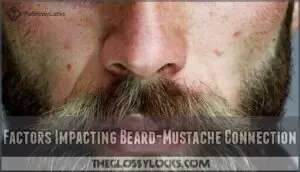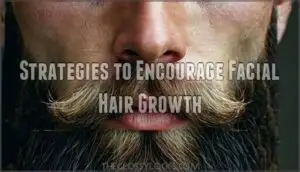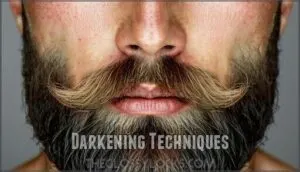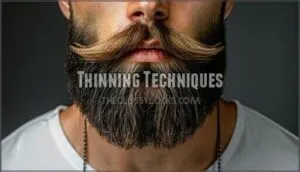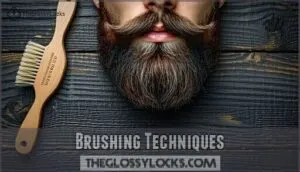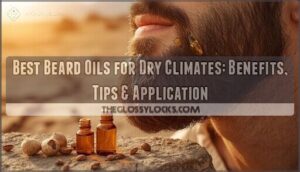This site is supported by our readers. We may earn a commission, at no cost to you, if you purchase through links.
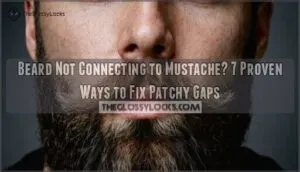
This patchy area between your upper lip and cheek hair happens because of genetics, hormones, and growth patterns that vary from person to person.
You can bridge these gaps through strategic growing techniques, proper nutrition, and targeted grooming methods.
Start by letting everything grow out for 6-8 weeks without trimming, and use beard oils to nourish follicles.
Consider styling tricks like brushing hair over sparse areas, as sometimes patience beats products in achieving that seamless connection you’re after.
Table Of Contents
- Key Takeaways
- Understanding Mustache Gaps
- Factors Impacting Beard-Mustache Connection
- Strategies to Encourage Facial Hair Growth
- Addressing Mustache Gaps: Growing It Out
- Enhancing Mustache Appearance
- Maintenance and Care for Beard and Mustache
- Seeking Professional Advice for Facial Hair Concerns
- Frequently Asked Questions (FAQs)
- Why does my moustache not connect to my beard?
- How to get a beard to connect to a mustache?
- Should moustache be connected to beard?
- Why does my beard grow but not my mustache?
- What to do if mustache and beard don’t connect?
- How to make a beard connect to a mustache?
- How do I fill the gap between my beard and mustache?
- What beard style is not connected to mustache?
- How do genetics affect beard shape?
- Can stress reduction improve beard health?
- Conclusion
Key Takeaways
- You’re dealing with genetics, not grooming mistakes – Your DNA determines where hair follicles develop, and some men simply don’t have roots in the gap area between beard and mustache, making this a biological reality rather than a fixable flaw.
- You need to commit to 3-4 months of patient growth – Stop trimming and let everything grow out completely, as longer mustache hairs can droop down to cover gaps and create the visual connection you’re after.
- You can use strategic styling tricks to fake the connection – Apply beard oil daily, brush mustache hairs downward toward your chin, and consider darkening techniques or fiber concealers to make existing hair appear fuller.
- You should embrace non-connecting beard styles if gaps persist – Classic looks like the Van Dyke, soul patch, or goatee work with natural growth patterns rather than fighting against them, creating a polished appearance without forcing connections.
Understanding Mustache Gaps
The dreaded mustache gap—that stubborn space where your facial hair refuses to connect—has a name: philtrum absence. This groove under your nose often lacks hair follicles entirely, creating a natural divide in your mustache.
The mustache gap isn’t a flaw—it’s your DNA’s way of keeping things interesting in the facial hair department.
Genetic predisposition plays the biggest role here. Your DNA determines where hair follicles develop, and some guys simply don’t have root absence in this area. Hormonal factors also influence growth patterns, with testosterone and DHT levels affecting follicle activity.
Understanding your growth expectations helps set realistic goals. Some men will never achieve a full mustache connection due to biology, while others need patience as their beard gap fills in over time. Recognizing whether you’re dealing with beard gaps from genetics or incomplete growth is your first step toward finding the right solution.
Factors Impacting Beard-Mustache Connection
Your beard’s connection to your mustache depends on several key factors that determine how your facial hair grows.
These include your genes, hormone levels, and how well you care for your beard.
Genetic Influence on Connectivity
Your genetic blueprint determines whether you’ll achieve seamless mustache connection or face stubborn gaps.
Inherited patterns from your family tree control follicle distribution across your face. Ethnic predispositions influence hair density, while specific gene expression regulates growth stages.
Understanding your genetics helps explain why some men effortlessly connect their patchy beard while others struggle with persistent beard gaps.
Follicle patterns are affected by the EDAR gene’s influence during development.
Hormonal Impact on Growth
Hormones drive your facial hair growth more than you might think.
Testosterone levels and DHT influence directly impact how well your beard connects to your mustache.
- Testosterone Levels: Higher testosterone promotes thicker, more connected facial hair growth
- DHT Influence: This hormone activates hair follicles in stubborn gap areas
- Hormonal Imbalance: Disrupted hormone levels create patchy, disconnected growth patterns
- Estrogen Conversion: Excess estrogen blocks beard growth hormones from working effectively
Low testosterone can be a factor, and may cause patchy facial hair.
Beard Care Techniques
While hormones set the foundation, proper beard grooming transforms patchy facial hair.
Beard oiling twice weekly nourishes follicles and softens coarse hairs. Balm application provides hold for styling a disconnected beard appearance.
Smart brush selection – boar bristle works best – trains hair direction. Strategic trimming frequency every two weeks maintains shape.
Consistent use of beard growth supplements can improve beard thickness. These styling techniques maximize your beard maintenance routine, creating fuller-looking beard styles that mask gaps effectively.
Strategies to Encourage Facial Hair Growth
You can boost your beard’s growth potential by making simple changes to your diet and daily habits.
These proven strategies target the root causes of patchy growth and help create the thick, connected facial hair you want.
Dietary Considerations
Nutritional foundations matter when you’re dealing with patchy facial hair. Your body needs specific building blocks to maximize growth potential.
Here are five key dietary strategies:
- Biotin Intake – Take biotin supplements to strengthen hair follicles
- Zinc Sources – Eat zinc-rich foods like pumpkin seeds and lean meats
- Vitamin D – Get adequate sunlight or consider supplements
- Protein Intake – Include lean proteins for keratin production
- Alfalfa Sprouts – Add these nutrient-dense greens to boost hormone levels
Lifestyle Changes
Beyond what you eat, your daily habits make or break facial hair growth.
Poor sleep quality stunts hormone production, while chronic stress kills follicles. Exercise benefits include boosting testosterone naturally. Smoking cessation improves blood flow to hair roots.
These beard growth tips help fix that stubborn beard gap.
| Lifestyle Factor | Impact on Growth | Quick Fix |
|---|---|---|
| Sleep Quality | Boosts testosterone | 7-8 hours nightly |
| Stress Reduction | Prevents hair loss | Daily meditation |
| Exercise Benefits | Increases hormones | Weight training 3x/week |
Avoiding Common Mistakes
Patience becomes your biggest ally when fixing that stubborn beard gap. Avoid over-trimming your facial hair too early—you’re sabotaging potential connections.
Don’t make the mistake of ignoring genetics by expecting overnight miracles. Impatience leads to constant trimming that prevents beard connection.
Stop neglecting skincare underneath your beard, as healthy skin grows stronger hair. Using wrong products can damage follicles.
Let your uneven beard grow for three months before evaluating your mustache gap and choosing appropriate beard styles.
Addressing Mustache Gaps: Growing It Out
Growing out your mustache might feel like watching paint dry, but it’s often the simplest solution for closing those stubborn mustache gaps. Patience is key when addressing beard and mustache connection issues—most men give up too early in the process.
Growing your mustache takes time, but patience beats giving up on those stubborn gaps.
Let your mustache grow for at least three months without trimming. This long-term commitment allows drooping mustache tips to naturally bridge the gap between your beard and mustache patches.
Training mustache hairs involves daily combing downward toward your chin, encouraging growth in the right direction. Styling for length means resisting the urge to trim during awkward growth phases.
Your mustache will look unruly at first, but longer hairs create the illusion of fullness. Use beard oil daily to keep growing hairs healthy and manageable. This approach works because longer mustache hairs can physically cover beard patches and create visual continuity across your entire facial hair.
Enhancing Mustache Appearance
You can make your mustache look fuller and more connected to your beard using simple styling techniques.
These methods help create the appearance of a seamless connection even when natural growth patterns leave gaps.
Darkening Techniques
Darkening techniques can dramatically transform your mustache’s appearance.
Dye application using specialized beard dye creates fuller-looking hair, while fiber concealers stick to existing strands for instant thickness.
Vellus coverage darkens light hairs that barely show, making gaps less obvious. Temporary stains from coffee grounds offer natural darkening.
Many people are now using hair darkening shampoo bars for gradual color enhancement.
Proper shade selection guarantees your enhanced mustache complements your beard styles perfectly.
Thinning Techniques
Strategic thinning techniques can transform your mustache’s appearance when gaps persist.
Use texturizing shears for point cutting to create natural texture. Razor thinning removes bulk while maintaining length.
These blending techniques and layering methods help achieve balanced beard styling.
For quality tools, consider purchasing texturizing shears.
Focus on beard shaping that complements nonconnecting beard styles.
Proper beard trimming creates symmetry, making gaps less noticeable through skillful beard styling approaches.
Brushing Techniques
Proper brushing transforms your mustache from unruly to refined. Start with a clean boar bristle brush – synthetic bristles can damage delicate facial hair. Brushing direction matters: sweep downward to cover gaps, then outward for fullness. Training hair takes patience but pays off.
A quality brush can be found by browsing a boar bristle selection.
Here’s your brushing game plan:
- Morning routine: Brush after applying beard oil for easier styling integration
- Technique combo: Alternate between downward and outward strokes for ideal coverage
- Brush cleaning: Rinse weekly to prevent buildup that affects performance
- Finishing touch: Follow with light wax to lock your beard styles in place
Maintenance and Care for Beard and Mustache
Proper care keeps your beard and mustache healthy while encouraging the growth you need to bridge those gaps.
You’ll want to focus on washing, conditioning, and using the right tools to create the best conditions for connecting facial hair.
Proper Washing and Conditioning
Clean beard grooming starts with the right wash frequency – use beard shampoo twice weekly with lukewarm water temperature to remove buildup without stripping natural oils.
Choose conditioner types with nourishing product ingredients like argan oil.
Pat dry gently using proper drying methods instead of harsh rubbing.
Consistent brushing can help with detangling and styling.
This mustache and beard care routine with quality beard products promotes healthier growth patterns.
Using Nourishing Oils
Nourishing your facial hair with beard oil transforms patchy areas into healthier growth zones.
Choose oils containing jojoba, argan, or coconut for maximum Oil Benefits. These essential oils penetrate deep, strengthening follicles and softening coarse hairs.
Proper Application Methods involve massaging oil into both skin and hair after washing. You can find effective beard growth solutions online.
Quality beard products create the foundation for better connectivity between your beard and mustache.
Comb and Brush Selection
Quality beard grooming tools make filling beard and mustache gaps easier.
Choose combs with fine teeth density for precision styling around patchy areas. Natural boar bristle brushes work best for distributing oils and training hair growth patterns.
Consider these game-changing features:
- Comb material: Wood prevents static and hair breakage
- Brush size: Compact designs reach tight spots near your mustache
- Handle design: Ergonomic grips give you complete control
Seeking Professional Advice for Facial Hair Concerns
Sometimes your beard and mustache patches need more than home remedies. When you’ve tried everything but still face stubborn gaps, it’s time to call in the pros.
A dermatologist consultation can uncover hidden issues affecting your facial hair. They’ll examine your skin, check hormone levels, and identify any underlying conditions blocking growth.
Beard specialists offer personalized solutions customized to your specific pattern and lifestyle. Medication options like prescription-strength minoxidil might be recommended for persistent patches.
Some men benefit from hair transplant procedures that move follicles from dense areas to sparse spots. Hormonal changes can sometimes affect hair growth patterns.
A beard growth consultation provides expert analysis of your genetics and growth potential. These professionals can suggest targeted treatments, nutritional supplements, or lifestyle changes that actually work for your unique situation.
Frequently Asked Questions (FAQs)
Why does my moustache not connect to my beard?
Your mustache doesn’t connect to your beard due to genetics, which create natural gaps where hair follicles are sparse or absent.
Age, hormones, and insufficient growth time also contribute to these common connection issues, making genetics a key factor in understanding the problem.
How to get a beard to connect to a mustache?
Struggling with patchy facial hair? Let your beard grow for three months without trimming. Use minoxidil daily, derma-roll weekly, and brush hair downward to cover gaps. Patience beats quick fixes.
Should moustache be connected to beard?
You don’t need your mustache connected to your beard.
Many classic styles like the Van Dyke or goatee look great with gaps.
It’s about finding what works for your face shape and personal style preference.
Why does my beard grow but not my mustache?
Don’t assume your facial hair’s broken.
Your mustache grows slower than your beard due to genetics and hormone distribution.
The philtrum area naturally has fewer follicles, making growth appear patchy or delayed.
What to do if mustache and beard don’t connect?
Try these proven fixes: let your facial hair grow for 3-4 months, use minoxidil daily, derma-roll weekly.
Style with balm to train hairs downward.
Or embrace non-connecting styles like the Van Dyke.
How to make a beard connect to a mustache?
Bridging the facial hair gap requires patience and strategy.
Let your beard grow for three months minimum, use minoxidil daily, try derma rolling weekly.
Style longer mustache hairs downward to create connection illusion.
How do I fill the gap between my beard and mustache?
Use minoxidil twice daily, derma-roll weekly with 5mm needles, and let your mustache grow longer to droop down.
Apply beard oil, brush hair toward gaps, and consider temporary fixes like Toppik fibers.
What beard style is not connected to mustache?
Like a puzzle with missing pieces, you can rock the Van Dyke style, which features a disconnected goatee and mustache.
You’ll also love the soul patch, chin curtain, or classic goatee—all stylishly separate from your mustache.
How do genetics affect beard shape?
Your genes control where hair follicles develop on your face, creating natural growth patterns.
Some areas like your cheeks or upper lip may have fewer follicles, resulting in gaps or patches.
Can stress reduction improve beard health?
You might think stress doesn’t affect facial hair, but chronic stress actually disrupts hormone levels that fuel beard growth.
When you manage stress through exercise, sleep, and relaxation, you’re boosting testosterone production for healthier facial hair.
Conclusion
Patience becomes your greatest ally when tackling a beard not connecting to mustache.
These seven strategies work together like puzzle pieces, each contributing to your facial hair goals.
Remember that genetics play a major role, so results vary between individuals.
Consistent care, proper nutrition, and strategic grooming create the best foundation for success.
Give your facial hair time to develop, maintain realistic expectations, and celebrate the progress you make along your grooming journey.

